Related Research Articles

A camera is an optical instrument that captures a visual image. At a basic level, cameras consist of sealed boxes, with a small hole that allows light through to capture an image on a light-sensitive surface. Cameras have various mechanisms to control how the light falls onto the light-sensitive surface. Lenses focus the light entering the camera. The aperture can be narrowed or widened. A shutter mechanism determines the amount of time the photosensitive surface is exposed to light.

A twin-lens reflex camera (TLR) is a type of camera with two objective lenses of the same focal length. One of the lenses is the photographic objective or "taking lens", while the other is used for the viewfinder system, which is usually viewed from above at waist level.

An instant camera is a camera which uses self-developing film to create a chemically developed print shortly after taking the picture. Polaroid Corporation pioneered consumer-friendly instant cameras and film, and were followed by various other manufacturers.

The Holga is a medium format 120 film camera, made in Hong Kong, known for its low-fidelity aesthetic.

In photography, a viewfinder is what the photographer looks through to compose, and, in many cases, to focus the picture. Most viewfinders are separate, and suffer parallax, while the single-lens reflex camera lets the viewfinder use the main optical system. Viewfinders are used in many cameras of different types: still and movie, film, analog and digital. A zoom camera usually zooms its finder in sync with its lens, one exception being rangefinder cameras.

A digital single-lens reflex camera is a digital camera that combines the optics and the mechanisms of a single-lens reflex camera with a digital imaging sensor.

Lubitel refers to any of the several medium format twin-lens reflex cameras manufactured in Russia by LOMO. The design is based on the early 1930s Voigtländer Brillant camera with various improvements.
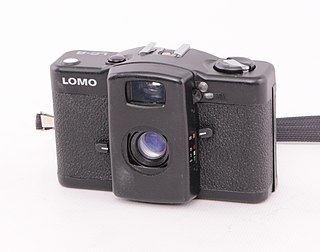
The LOMO LC-A is a fixed lens, 35 mm film, leaf shutter, zone focus, compact camera introduced in 1984. Its design is based on the Cosina CX-2, with the difference being that it lacks a swiveling front and self-timer. It was built in Soviet-era Leningrad by Leningrad Optics and Mechanics Association (LOMO).
The following outline is provided as an overview of and topical guide to photography:

Live preview is a feature that allows a digital camera's display screen to be used as a viewfinder. This provides a means of previewing framing and other exposure before taking the photograph. In most such cameras, the preview is generated by means of continuously and directly projecting the image formed by the lens onto the main image sensor. This in turn feeds the electronic screen with the live preview image. The electronic screen can be either a liquid crystal display (LCD) or an electronic viewfinder (EVF).

The Nikkorex nameplate was used for a series of 35 mm film, single-lens reflex cameras sold by Japanese optical manufacturer Nippon Kogaku K.K., as well as a series movie cameras and movie projectors. The models, made by other companies, were designed and marketed as low-cost, feature-reduced equipment for the consumer market.

Instax is a brand of instant still cameras and instant films marketed by Fujifilm.
The Fujifilm FinePix S200EXR is a digital bridge camera from Fujifilm introduced in July 2009.
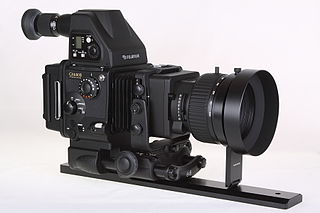
The Fuji GX680 is a series of single lens reflex system cameras for medium format film produced by Fujifilm with interchangeable camera lenses and interchangeable film holders for the unusual film format 6×8 cm on 120 and 220 roll film. The distinguishing feature of the Fuji GX680 is the articulating front standard, which runs on a rail connecting lens and camera body by a bellows; the interchangeable lens is permanently mounted to a lens board.

The Fujifilm X series is a line of digital cameras produced by Fujifilm. The series encompasses fixed lens and interchangeable lens mirrorless cameras and premium compact point-and-shoot cameras aimed at consumer, enthusiast and professional photographers. The X series is part of the larger FinePix range of digital cameras from Fujifilm.
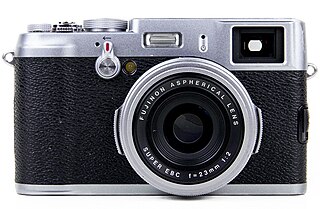
The Fujifilm X100 is a series of digital compact cameras with a fixed prime lens. Originally part of the FinePix line, then becoming a member of the X series from Fujifilm, the X100 series includes the FinePix X100,X100S,X100T,X100F, and X100V. They each have a large image sensor and a 23 mm lens. All five cameras have received generally positive reviews.
MiNT Camera is a company specializing in instant cameras and its accessories. Founded in 2009, it provides products and services related to instant photography. MiNT Camera has partnered with Impossible Project, now Polaroid, a manufacturer of instant photographic materials. MiNT is a well-established player in the instant photo market.
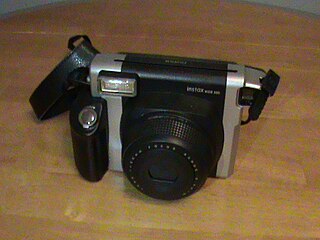
The Fujifilm Instax Wide 300 is an analog instant camera from Fujifilm that uses Instax Wide instant film. It has a moderately wide-angle lens with some manually selectable fixed focus zones and a fixed aperture.
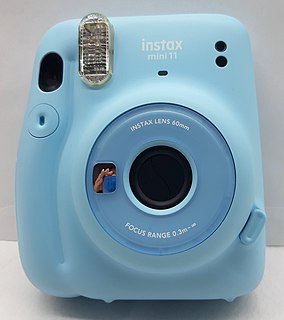
The Instax Mini 11 is an analog instant film camera designed, developed, marketed, and sold by Fujifilm. The Instax camera is the successor to the Instax Mini 9 and was released in March 2020.
References
- 1 2 "Features". Lomography. Retrieved 2020-07-08.
- ↑ "Lomography Lomo'Instant Square: Digital Photography Review". Digital Photography Review . Retrieved 2020-07-08.
- ↑ Byford, Sam (29 August 2017). "Lomography is making an instant camera that uses square Instax film". The Verge. Retrieved 2020-07-08.
- ↑ "Lomo'Instant Square now works with Fujifilm Instax Mini Film". Amateur Photographer. 21 September 2017. Retrieved 2020-07-08.
- 1 2 3 4 5 "If You Love Square Instant Photos, This Camera Delivers 'Em". Wired. Retrieved 2020-07-08.
- 1 2 3 "Best instant cameras in 2020". Digital Photography Review . Retrieved 2020-07-08.
- 1 2 3 "Lomography Lomo'Instant Square". PC Magazine . 21 February 2018. Retrieved 2020-07-08.
- ↑ "Lomo'Instant Square Wide-Angle Glass Lens Attachment". Lomography. Retrieved 2020-07-08.
- ↑ "Lomo'Instant Square: The First Analog Instant Cam for Instax Square Film". petapixel.com. Retrieved 2020-07-19.
- ↑ "Review: Lomo'Instant Square Glass". YouTube. Photography Concentrate. Retrieved 2020-07-19.
- ↑ Rear, Jack (23 October 2018). "The best instant cameras for quickly printing pictures". The Daily Telegraph. ISSN 0307-1235 . Retrieved 2020-07-08.